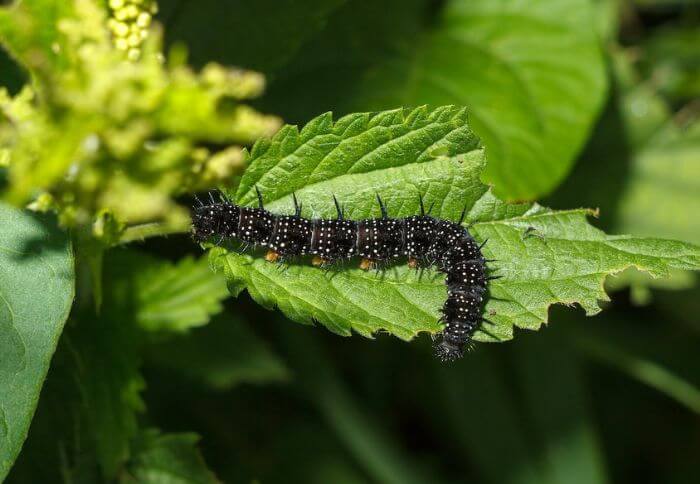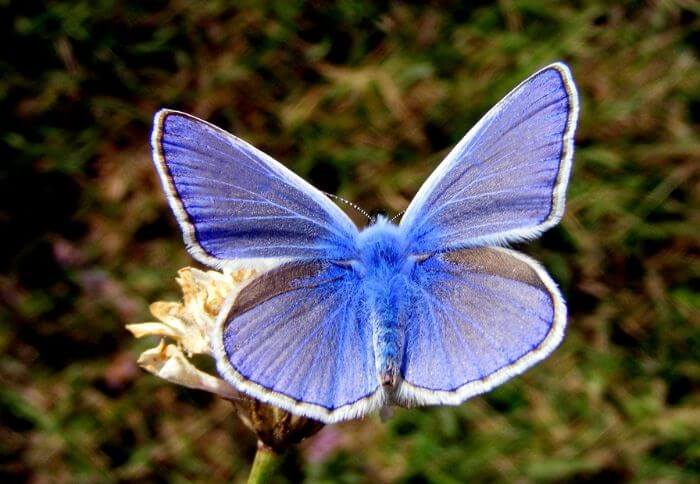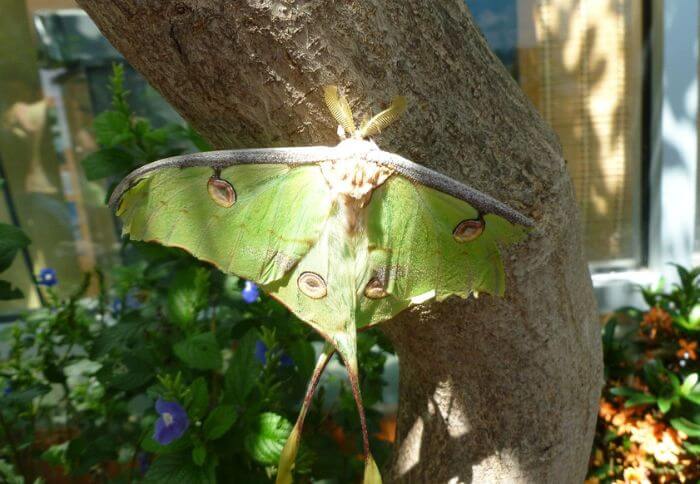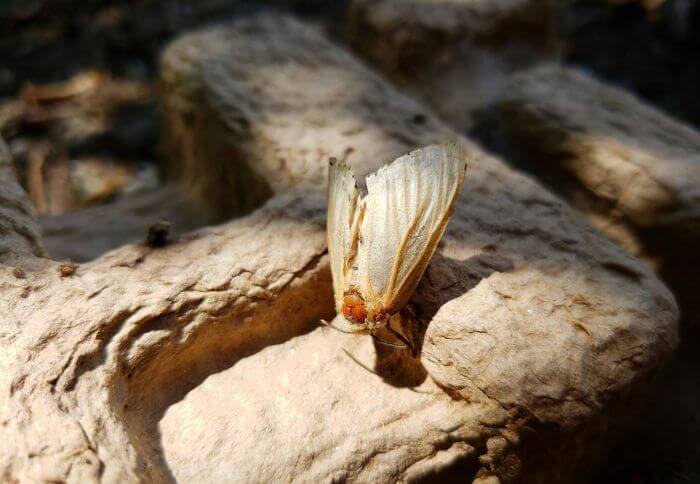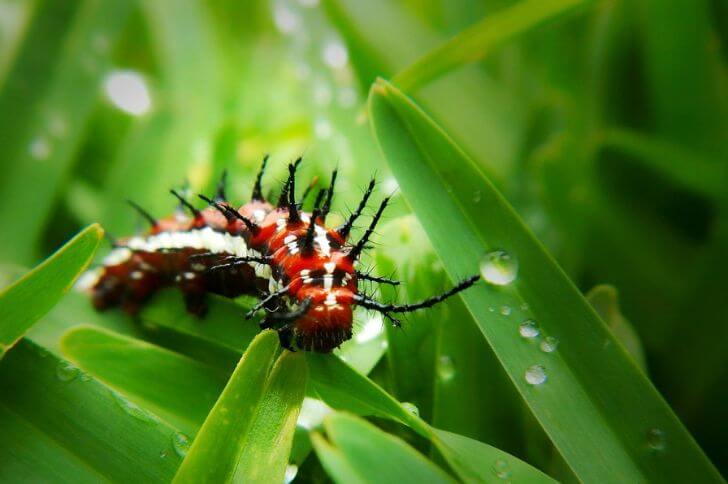Yellow Fuzzy Caterpillar (13 Species Identification)
Yellow fuzzy caterpillars are often overlooked in the world of insects, overshadowed by their more colorful and flamboyant counterparts. However, these unassuming creatures possess a charm of their own with their soft, velvety bodies covered in vibrant yellow hairs.
Found in various habitats around the world, these caterpillars belong to different species, each displaying unique characteristics and behaviors. From the strikingly bright yellow American dagger caterpillar to the elegantly patterned grass eggar moth caterpillar , this article explores some of the most fascinating types of yellow fuzzy caterpillars that can be found in nature.
Yellow Fuzzy Caterpillar (list and identification)
1. American Dagger Moth Caterpillar
The American Dagger Caterpillar, with its vibrant yellow color and long black spines, is a fascinating creature that can be found across North America.
But don’t let its fluffy appearance fool you – this caterpillar packs a powerful punch with its venomous spines. As tempting as it may be to touch these adorable-looking creatures, it’s important to exercise caution.
The stings from this yellow hairy Caterpillar can cause intense pain, swelling, and allergic reactions in some people.
Despite their potent defense mechanism, these caterpillars play an important role in our ecosystem. They primarily feed on various trees such as box elder, maple and willow, thus playing a part in regulating plant growth and maintaining biodiversity.
In addition to being food sources for birds and other animals, they also serve as host organisms for parasitic wasps – another crucial component of our natural environment.
While the American Dagger Caterpillar may not possess dazzling patterns or intricate markings like some of its yellow fuzzy caterpillar counterparts, it more than makes up for it with its distinctive appearance and intriguing behaviors.
2. Sycamore Tiger Moth Caterpillar (Halysidota Harrisii)
One of the most adorable and unique fuzzy caterpillars you may encounter in nature is the sycamore tiger moth caterpillar, scientific name halysidota harrisii caterpillar.
This fascinating creature stands out with its vibrant yellow hairs that cover its entire body, creating an almost fluffy appearance. Note the orange and white spikes on the front and back of its body.
Despite its cute exterior, this caterpillar is not to be taken lightly as it possesses tiny barbed hairs that can cause irritation if touched.
In addition to providing a visual treat for anyone lucky enough to spot one, these yellow fuzzy caterpillars play an essential role in maintaining ecological balance. As they munch through leaves during their larval stage, they serve as important herbivores within their ecosystems.
Furthermore, these remarkable insects eventually transform into beautiful moths known for their pale yellow wings with bands on their wings – a stunning contrast to their previously fluffy-looking selves.
3. Acronicta Aceris Caterpillar
One of the most enigmatic yellow fuzzy caterpillars is the acronicta aceris caterpillar. With its vibrant yellow color, orange spikes and velvety texture, it captures attention instantly. However, what makes this particular species unique is not just its appearance but also its interesting feeding habits.
Unlike many caterpillars that feed on a specific plant or leaf, the Acronicta aceris is known to be a generalist feeder. This means it has a varied diet and can consume a wide range of plants – from birch and oak to willow and maple leaves.
4. Yellow Hairy caterpillar (Psalis pennatula)
With its long striped body and orange spots, the yellow hairy caterpillar (psalis pennutula) is a remarkable creature that often goes unnoticed amidst the vibrant display of its more showy counterparts.
With its velvety yellow coat adorned with whitish hairs, this caterpillar may not boast bold patterns or dazzling colors, but it certainly captivates with its unique appearance.
Its body is elongated and slender, resembling a delicate feather. But don’t be fooled by its seemingly fragile form; this caterpillar possesses an arsenal of surprising defenses.
One of the most intriguing traits of the Psalis pennatula caterpillar is its defense mechanism. This species has stinging hairs – tiny daggers disguised beneath their soft appearance. When disturbed or touched, these little warriors inject an irritating venom into their attackers’ skin which can cause pain and inflammation for days.
5. Grass Eggar Moth Caterpillar
One particularly intriguing yellow hairy caterpillar that can be found crawling among the foliage is the Grass Eggar Moth Caterpillar. With its pale yellow color and soft, furry exterior, it is hard not to be captivated by this unique creature.
What sets this caterpillar apart from others is its ability to change its appearance as it grows. As a young larva, it sports bright green hues that help it blend seamlessly with the surrounding grasses. As it matures, however, its colors shift to a pale yellow tone with black spots, making it stand out against its surroundings.
This adaptive camouflage allows the caterpillar to remain hidden from predators during different stages of its life cycle.
The fuzziness of the Grass Eggar Moth Caterpillar not only serves as an aesthetic feature but also plays a vital ecological role.
The fluffy hairs on their bodies act as insulation and help regulate their body temperature. In colder climates or during chilly nights, these tiny hairs trap air close to their skin and create a layer of insulation which helps keep them warm. Additionally, the fuzzy nature of these caterpillars can deter predators since many animals find them unpleasant to touch or eat due to their spiky texture.
6. Pale Tussock Caterpillar
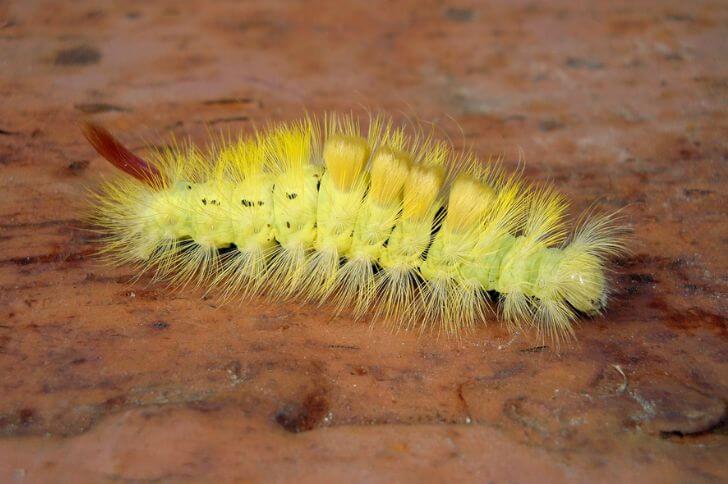
One of the most eye-catching caterpillars you may come across is the Calliteara pudibunda Caterpillar, also known as the Pale Tussock Moth Caterpillar. Sporting a vibrant yellow body covered in soft, fuzzy hairs, this caterpillar makes a bold statement wherever it goes.
But its striking appearance isn’t just for show – those hairs are actually a defensive mechanism to protect it from predators.
But what sets this yellow fuzzy caterpillar apart from other caterpillars is its unique way of moving. While many caterpillars crawl along using their many legs, this fuzzy creature has an interesting and distinctive way of locomotion.
Instead of fully extending its body when moving forward, it bends upward and then stretches out flat like an accordion. This undulating motion gives it a mesmerizing and somewhat comical look as it inches along tree branches or leaves.
While other yellow fuzzy caterpillars may blend into their surroundings with ease, the pale tussock moth caterpillar stands out boldly against any backdrop. Its coloration is a warning to predators.
By proudly displaying its bright hue and fuzziness, this caterpillar is essentially saying stay away! It’s fascinating how nature has equipped this seemingly defenseless creature with such effective protection strategies.
7. Santa Ana Tussock Moth Caterpillar
With its fuzzy yellow body, white spikes and black head, the santa ana tussock moth caterpillar is another caterpillar that fits this category.
Common in Texas and Arizona, these small yellow fuzzy caterpillars have a voracious appetite. They feed in clusters which may lead to destruction of Aegiphila falcata, the only shrub species they feed on.
8. Spotted Apatelodes Moth Caterpillar
While exploring the vibrant world of yellow fuzzy caterpillars, one peculiar species that caught my attention is the Spotted Apatelodes Moth Caterpillar. With its distinct yellow and black markings, this fuzzy creature appears like a tiny work of art in motion.
What sets it apart from other caterpillars is its ability to camouflage itself among tree bark or dried leaf litter. This clever adaptation allows it to hide from potential predators while preparing for its stunning transformation into an equally beautiful moth.
This yellow fuzzy caterpillar follows a unique life cycle that spans several stages. After emerging from their eggs, these caterpillars undergo multiple molts, shedding their old exoskeletons to accommodate their growing bodies.
As they progress through each stage, their colors intensify and the characteristic spines on their bodies become more pronounced. It’s truly fascinating how nature bestows such intricate patterns and features upon these creatures in order to ensure their survival.
Observing the behavior of this caterpillar reveals remarkable characteristics that make them worth admiring even more. From their little marching processions as they search for food to how they sway rhythmically when disturbed – there is a beauty in every movement they make.
In addition, despite being covered with soft-looking hairs called setae that may seem harmless at first glance, touching them can result in itching or irritation due to certain toxins present on their bodies as a form of defense mechanism.
9. Yellow Woolly Bear Caterpillar
The sight of a yellow woolly bear caterpillar crawling across a leaf can be both intriguing and mesmerizing. These fuzzy creatures, with their yellow bodies and soft bristles, have a unique appearance that immediately captures attention.
But what makes them even more captivating is the mystery surrounding their future transformation into a white moth.
One fascinating aspect of the yellow woolly bear caterpillar is its ability to adapt to different environments. As they mature, these caterpillars change color, transitioning from their initial yellow hue to dark brown.
This change not only helps them blend in with their surroundings but also offers protection against predators. By camouflaging themselves effectively, they increase their chances of survival in the wild.
10. Virginia Ctenucha Caterpillar
Ranging from Virginia to Alberta, the Virginia Ctenucha caterpillar is an intriguing creature, with its bright yellow and black striped body and tufts of long hair. These caterpillars are often spotted in meadows and grassy areas, feasting on a wide variety of plants.
What makes them particularly fascinating is their ability to camouflage themselves among the foliage by incorporating bits of plants into their hairy exteriors.
Is this yellow hairy caterpillar poisonous? No, though the Virginia ctenucha caterpillar looks dangerous it is not venomous.
11. Cottonwood Dagger Caterpillar
Ranging from Michigan to Wyoming to New Brunswick, the cottonwood dagger moth caterpillar is a fascinating insect that is easy to identify. With its vibrant yellow body and black spikes and a dense covering of long, soft hairs, this caterpillar has a distinct and eye-catching appearance.
But don’t be fooled by its adorable exterior – the black spines can cause irritation to human skin upon contact.
Unlike traditional caterpillars that rely on camouflage to evade predators, the Cottonwood Dagger Caterpillar takes a different approach. Its bright colors serve as a warning sign to potential threats that it is toxic and should not be messed with.
This warning coloration phenomenon called aposematism is quite common in the animal kingdom but is especially striking when witnessed in these fuzzy caterpillars.
Interestingly, despite being venomous, this yellow hairy caterpillar plays an essential role in promoting biodiversity. Its preferred food source includes cottonwood trees and willows – both dominant plant species found near rivers and streams across North America.
By consuming leaves from these plants, the caterpillar helps regulate their growth while simultaneously providing sustenance for other organisms along the ecological chain.
The next time you come across one of these brightly colored fuzzballs crawling on a tree trunk or leaf during your nature hike or leisurely walk through your backyard garden, take a moment to observe their intricate beauty up close – just remember to admire from afar!
12. Stinging Rose Caterpillar
The sight of a fuzzy yellow caterpillar often brings about a sense of curious fascination, but what if I were to tell you that some of these seemingly harmless creatures could pack quite a punch? Enter the stinging rose caterpillar, undoubtedly one of nature’s most unexpected paradoxes.
With its vibrant yellow appearance and sharp yellow spikes, it lures unsuspecting onlookers into thinking that it is nothing more than an adorable creature. However, those who dare to touch or disturb this innocent-looking crawler are in for an unpleasant surprise.
This fascinating insect may appear small and cute, but its spikes hold a secret weapon – venomous spines capable of inflicting painful stings on anyone unfortunate enough to come into contact with them.
The sting from a stinging rose caterpillar causes intense itching, burning sensations, and can even lead to swelling. While not life-threatening, the discomfort it inflicts is hard to ignore. It’s interesting how such a harmless-looking creature possesses such potent defensive mechanisms – a gentle reminder that appearances can be deceiving in the natural world.
Next time you stumble upon one of these fluffy yellow caterpillars during your outdoor adventures, remember– looks can be deceiving. These seemingly benign creatures are equipped with an effective defense mechanism against potential threats.
13. White-Marked Tussock Moth Caterpillar
The sight of a yellow and black fuzzy caterpillar crawling across the ground can be fascinating, but have you ever encountered a white-marked tussock moth caterpillar?
These little critters may not sport the vibrant yellow fur of their counterparts, but they are equally mesmerizing in their own right. With a striking black mustache and white hair tufts running along its back, this caterpillar grabs attention wherever it goes.
One unique feature of the white-marked tussock moth caterpillar is its distinct red head. Unlike many other fuzzy caterpillars that have black or pale yellow heads, this particular species has a bright red head with a notable black mustache. These black hairs provide an extra layer of protection against potential predators by acting as a warning signal to stay away.
The intriguing thing about these caterpillars is that while they might look cuddly with all those furry tufts, they can actually cause skin irritation upon contact.
Final Thoughts:
In conclusion, yellow fuzzy caterpillars come in a variety of types and can be found in various habitats around the world. From the bright and bold colors of the yellow woolly bear caterpillar to the intricate patterns of the grass eggar moth caterpillar, these creatures never fail to capture our attention.
Despite their harmless appearance, some yellow hairy caterpillars possess venomous spines that serve as a defense mechanism against predators. It is important to appreciate these fascinating creatures from a safe distance and avoid handling them without proper knowledge or protection.
By educating ourselves about the different types of yellow fuzzy caterpillars and respecting their natural habitats, we can ensure their continued presence in our ecosystems for generations to come.
source:

Passionate animal enthusiast and skilled writer with a flair for captivating storytelling. With over five years of experience, I have crafted engaging content that sheds light on the fascinating world of animals.
Through my articles, blog posts, and social media campaigns, I strive to raise awareness about conservation efforts and promote a deeper understanding of the natural world.
